In today’s digital landscape, the rivalry between mobile and desktop usage has captured our attention, shaping the way we interact with technology and consume content.
Join us on an insightful data-driven exploration as we uncover mind-blowing statistics that highlight the dominance of mobile/desktop usage, such as the astonishing fact that mobile devices accounted for over 70% of global internet traffic in 2024, showcasing their pivotal role in our online activities.
Table of Contents
- Our Top 5 Mobile vs Desktop Statistics
- Mobile vs Desktop General Stats
- Mobile vs Desktop Search Statistics
- Mobile vs Desktop Video Statistics
- Mobile vs Desktop Social Media Statistics
- Mobile vs. Desktop Ecommerce Statistics
- Mobile vs. Desktop Gaming Statistics
- Mobile vs. Desktop News Consumption
- Mobile vs. Desktop Travel and Booking Statistics
- Mobile vs. Desktop Streaming Statistics
- Conclusion
Our Top 5 Mobile vs Desktop Statistics
- 70% of American gamers prefer gaming on smartphones, accounting for 50% of global gaming revenue.
- 90% of US adults access news through mobile devices, with smartphones expected to account for 35% of all media consumption by 2023.
- Mobile banking is the primary choice for 5% of US consumers, with global mobile banking users reaching 2.02 billion in 2021.
- 70% of travelers research on mobile devices, and mobile travel booking rates increased to 41% in 2021.
- Over 70% of YouTube watch time comes from mobile devices, and mobile streaming dominates in Asia, accounting for 45% of viewing time.
Mobile vs Desktop General Stats
Here are some fascinating statistics that shed light on the growing dominance of mobile over desktop usage:
- According to a report by Statista in 2021, the average American spends an impressive 4 hours and 23 minutes on a mobile device each day. This significant figure reflects the increasing reliance on mobile technology for various activities and entertainment.
- When it comes to the global market share, mobile devices hold a substantial lead, accounting for 55% compared to desktops with 45%. These findings from Statcounter highlight the widespread adoption of mobile devices worldwide and the diminishing significance of traditional desktop usage.
- Furthermore, the number of active mobile internet users has reached an astonishing 32 billion. This staggering figure underscores the pervasive nature of mobile connectivity and the accessibility it provides to a vast population across the globe.
Mobile vs Desktop Search Statistics
When it comes to search behavior, mobile devices have taken the lead, shaping the way we find information and interact with search engines.
1. Mobile Dominance in Web Visits
Mobile devices have emerged as the preferred medium for browsing the web, surpassing desktop usage in various regions:
- In the United States, mobile accounts for 08% of total web visits, while desktop contributes 47.92%. (Oberlo)
- Globally, mobile devices command a significant share of web traffic, capturing 67% in February 2023 and maintaining an average of 60.06% throughout the year. (Oberlo)
Global Mobile Phone Website Traffic Share (2012 to 2023)

- Africa leads the pack with an impressive 13% of internet traffic originating from mobile devices. (Explodingtopics)
Infographic 2. Regions with the highest share of mobile internet traffic
2. Google and Mobile Search Traffic
Mobile devices play a pivotal role in driving organic search traffic, particularly on Google’s platform.
- In the United States, 63% of Google’s organic search traffic originates from mobile devices, underlining the significance of mobile search. (Oberlo)
- On a global scale, mobile devices contribute to over half of the web traffic generated through search engines. (Statista)
3. Impact on Search Results
The transition from desktop to mobile search did not only influenced user behavior but also resulted in divergent search results:
- Approximately 35% of search queries yield different top-ranking results when comparing mobile and desktop search engine result pages (SERPs).
- Analyses of over 84 million keywords indicate that desktop searches make up more than 55% of all searches, while mobile searches reach a maximum of 45%. (Sistrix)
4. Mobile Device Website Traffic
Mobile devices continue to dominate website traffic, both globally and in the United States.
- In the first quarter of 2023, 45.49% of web traffic in the United States originated from mobile devices, compared to over half of web traffic worldwide. (Statista)
Percentage of Mobile Device Website Traffic in the United States from Q1 2021 to Q1 2023
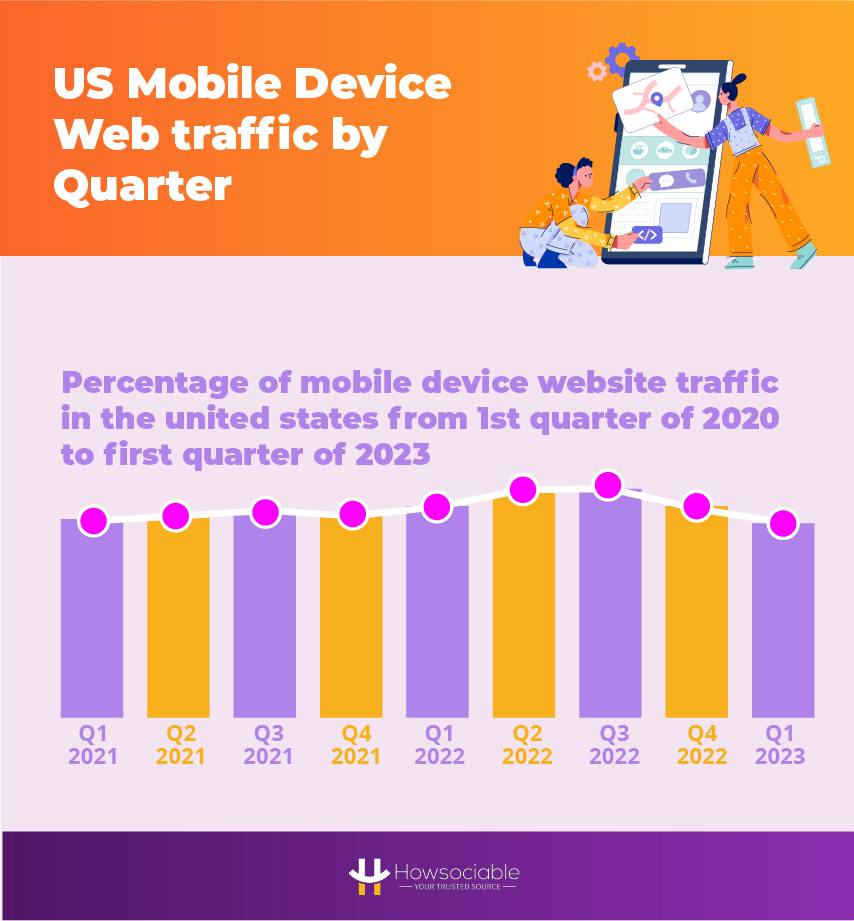
- Mobile devices (excluding tablets) accounted for 58.33% of global website traffic in the first quarter of 2023, surpassing the 50% mark consistently since 2017. (Statista)
5. User Behavior and Click-through Rates
Mobile users exhibit slightly different search behavior compared to desktop users:
- Just under 30% of mobile searches result in clicks on the first result, while approximately 36% of desktop users click on the first result. (Sistrix)
- Mobile searches have a click-through rate of nearly 85%, while desktop searches have a rate of 5%. (Sistrix)
6. Search Result Discrepancies
Search results may vary between mobile and desktop platforms, indicating the need for tailored optimization strategies.
- Over 62% of organic searches display different results on desktop and mobile devices, indicating disparities in search results between the two platforms. (BrightEdge).
- More than 6 out of the top 10 search results are likely to differ between desktop and mobile searches. (Techjury)
These statistics highlight the dominance of mobile devices in search activities and the consequential variations in search results between mobile and desktop platforms.
Mobile vs Desktop Video Statistics
Mobile devices have transformed the way we watch and share videos. Let’s explore the statistics that shed light on the disparities between mobile and desktop video consumption.
1.Mobile Video Consumption Growth
The popularity of mobile video consumption has skyrocketed in recent years, with billions of users worldwide embracing the convenience of watching videos on their smartphones.
- In 2017, there were already 67 billion users globally watching video content on their mobile phones, and this number was projected to exceed 2.33 billion by 2021 (Statista).
2. Business Videos on Desktop
While mobile video consumption is on the rise, desktop platforms still hold a significant share of business-related video views.
- Surprisingly, 87% of business-related videos are viewed on desktop, suggesting that professionals still prefer the larger screens and focused environments that desktop devices offer (Invideo).
3. Mobile Video Sharing Behavior
Mobile users are actively engaged in sharing videos, indicating the social nature of mobile video consumption.
- An astounding 92% of video consumers (mobile) share videos with others, demonstrating the eagerness to spread interesting and engaging video content among their networks (Crisp).
4. Dominance of Mobile Video Plays
Mobile devices have emerged as the preferred medium for video playback, dominating the majority of video plays.
- Over 75% of all video plays occur on mobile devices, underscoring the preference for watching videos on smartphones and tablets (eMarketer).
5. Mobile Video Engagement on YouTube
The rise of mobile video consumption is particularly evident on YouTube, the world’s largest video-sharing platform.
- YouTube reports that 70% of video consumption on their platform takes place on mobile devices, indicating the significant role mobile plays in driving viewership (YouTube).
6. Business Video Reach on YouTube
The inclusion of mobile consumption extends the reach of YouTube channels, amplifying their audience.
- On average, each of the top 50 YouTube channels experienced a 218% increase in their desktop audience (reach) when accounting for consumption on smartphones and tablets (Techjury).
7. Mobile Video Ad Viewability
When it comes to video ad viewability, mobile users have a distinct advantage over desktop users.
- Google data reveals that video ad viewability is significantly higher among mobile users (83%) compared to desktop users (53%), highlighting the effectiveness of mobile devices in delivering video ads (Business2Community).
Mobile vs Desktop Social Media Statistics
Here, we will explore the statistics that highlight the disparities between mobile and desktop usage across popular social media platforms.
1. Twitter Video Views
Twitter has witnessed a staggering 2 billion views on videos each day, with 90% of those views originating from mobile devices. This showcases the significant role of mobile in driving video engagement on the platform. (Twitter)
2. Mobile Dominance in Social Media Browsing
Mobile devices dominate social media browsing, with approximately 80% of users accessing social media platforms through their mobile devices (Techjury). This trend is consistent across various countries.
- Indonesia and India leading the pack, where 91% of online minutes are spent on mobile devices, followed by Brazil at 85%. (Smart insights)
3. Facebook Access via Smartphones
Facebook users aged 18 and above show a clear preference for accessing the platform through their smartphones.
- According to datareportal, an overwhelming 8% of Facebook users in this age group access the platform exclusively through their smartphones. In contrast, only 1.5% solely use desktop, while 16.7% use both devices.
4. Mobile Usage on Twitter
Mobile devices play a vital role in Twitter usage, shaping the way users engage with the platform.
- Twitter has witnessed a significant shift towards mobile access, with 60% of its 200 million active users logging in via a mobile device at least once a month.
This indicates the widespread use of smartphones for accessing Twitter and staying connected.
- Furthermore, primary mobile users on Twitter are 47% less likely to use the platform on desktop than average Twitter users.
These mobile users are not only more frequent in checking Twitter but also more active in composing original tweets, retweeting, and engaging with content.
5. Mobile Traffic on Pinterest
Pinterest has become synonymous with visual content discovery, and mobile devices have become the go-to medium for engaging with the platform.
The convenience and accessibility offered by mobile apps have propelled Pinterest’s mobile usage to new heights.
- As reported by omnicore, a remarkable 85% of Pinterest users primarily access the platform through the mobile app.
6. LinkedIn Mobile Traffic
LinkedIn, the professional networking platform, has witnessed a significant increase in mobile usage among its users.
Mobile devices have become indispensable tools for professionals, enabling them to access LinkedIn on the go.
- According to LinkedIn’s own data, 57% of the platform’s traffic originates from mobile devices.
7. Mobile Engagement on YouTube
As the largest video-sharing platform, YouTube attracts a massive audience, and mobile devices play a critical role in its engagement.
Mobile users on YouTube have demonstrated a strong preference for consuming video content on their smartphones or tablets.
- Mobile users visit twice as many pages on YouTube compared to desktop users.
Mobile vs. Desktop Ecommerce Statistics
Mobile devices have revolutionized the way people engage in online shopping. Below are the statistics that highlight the contrasting dynamics between mobile and desktop platforms in the realm of ecommerce.
1. Mobile Dominance in Online Purchases
Mobile devices have become the preferred choice for making online purchases
- A staggering 91% of shoppers using smartphones to complete transactions (Forbes).
2. Mobile Ecommerce Growth
The growth of mobile ecommerce is evident as more consumers turn to their smartphones for making online purchases.
- In 2022, mobile devices accounted for 60% of all ecommerce transactions, underscoring the increasing importance of mobile commerce (Dash).
3. Frequent Mobile Ecommerce Transactions
Mobile ecommerce has become ingrained in the daily lives of internet users.
- 29% of them make at least one ecommerce transaction on their phones every week (Dash).
This trend is even more pronounced in certain countries, as reflected in the top 10 countries by mobile ecommerce purchases.
Top 10 Countries by Mobile Ecommerce Purchases
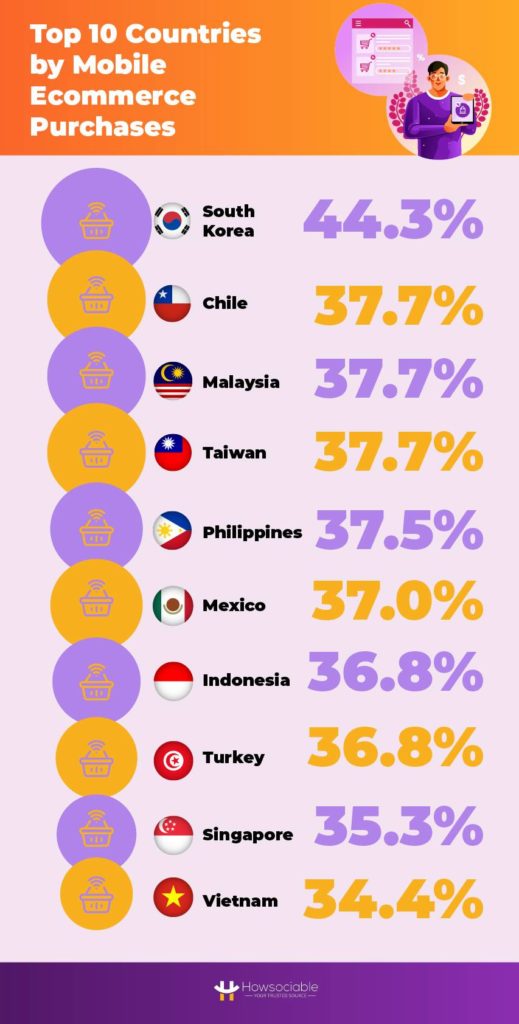
4. Online Shopping Cart Abandonment Rates
Despite the popularity of mobile shopping, the online shopping cart abandonment rate on mobile devices is alarmingly high at 84%.
In contrast, the abandonment rate on desktops is comparatively lower at 72% (Statista). This indicates potential challenges in the mobile user experience during the purchasing process.
Abandonment Rate in the US by Device During Online Shopping (Q2 2021 – Q2 2022)
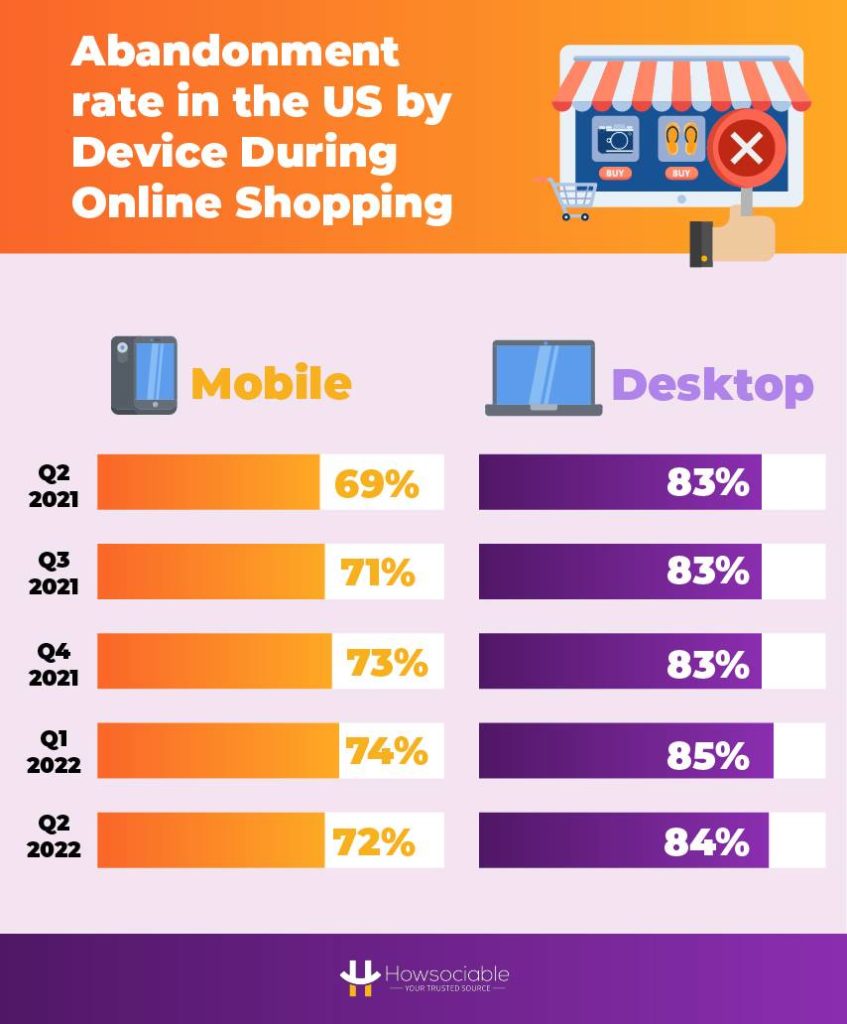
Cyber Monday Mobile Shopping
Surge Cyber Monday, one of the busiest online shopping days, witnessed a significant shift towards mobile devices.
- In 2022, a record-breaking 59% of shoppers conducted their online purchases on their mobile devices during Cyber Monday, marking a notable increase from 52% in 2021 (Forbes).
5. Mobile’s Impact on Ecommerce Sales
Mobile shopping plays a pivotal role in driving overall ecommerce sales.
- It accounts for a substantial 63% of all e-commerce sales (Manaferra).
6. Conversion Rates: Mobile vs. Desktop
While average smartphone conversion rates are impressively 64% higher than desktop conversion rates, the conversion rate among U.S. online shoppers is generally higher for desktop users.
- In the 2nd quarter of 2022, desktop visits to e-commerce websites yielded a 3% conversion rate, compared to a 2% conversion rate for smartphone visits (Statista).
Online Shoppers Conversion rate by device (Q2 2021 – Q2 2022)
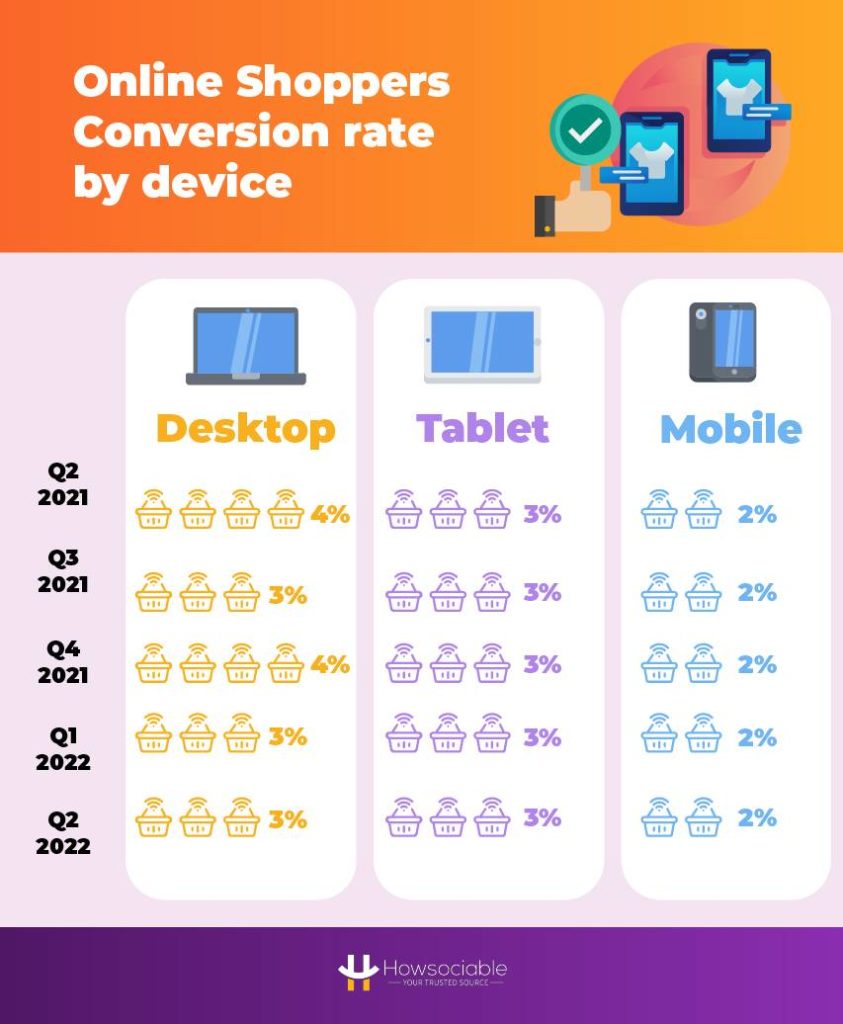
By examining these statistics, it becomes evident that mobile devices have significantly influenced the ecommerce landscape, with a shift towards mobile devices in online shopping behavior.
Mobile vs. Desktop Gaming Statistics
There’s a significant shift in user preferences in the gaming industry, with mobile and desktop platforms emerging as key contenders. The below statistics/findings highlight the contrasting patterns of mobile and desktop usage in gaming.
1. Mobile Gaming Takes Center Stage
The convenience and accessibility of mobile devices have propelled the popularity of mobile gaming, leading to a surge in user engagement and revenue.
- 70% of American gamers opt for smartphones as their preferred gaming platform, surpassing gaming consoles (52%) and PCs (43%). (Vpnalert)
American Gamers Opt for Smartphones the Most

- Female gamers show a strong affinity for mobile gaming, with 94% choosing to play video games on their mobile devices. (Vpnalert)
2. Dominance of Mobile in Gaming Revenue
Mobile gaming has become a dominant force in the gaming industry, contributing to a substantial share of the global gaming revenue.
- Mobile games generate 50% of the total global gaming revenue, projected to reach $92.2 billion in 2022 out of the estimated $183.5 billion global gaming market revenue.
- The mobile gaming market is expected to grow to $172.10 billion by 2023. (Source)
3. Desktop Gaming’s Enduring Appeal
While mobile gaming has witnessed a meteoric rise, desktop platforms continue to retain a significant user base and offer unique advantages.
- Globally, 798 billion people engaged in gaming on desktop computers in 2022, and this number is anticipated to reach 1.855 billion by 2024 (Vpnalert).
- Asia accounts for 33% of all PC gamers, with Europe following closely behind, boasting approximately 468.4 million PC gamers.
4. The Future of Mobile and Desktop Gaming
As gaming preferences evolve, both mobile and desktop platforms are poised for growth and innovation.
- The online PC game market is valued at $41.9 billion, and is projected to decline to $41.3 billion by 2027. (Statista)
Worldwide Online PC Gaming Market Value (2020 – 2027)
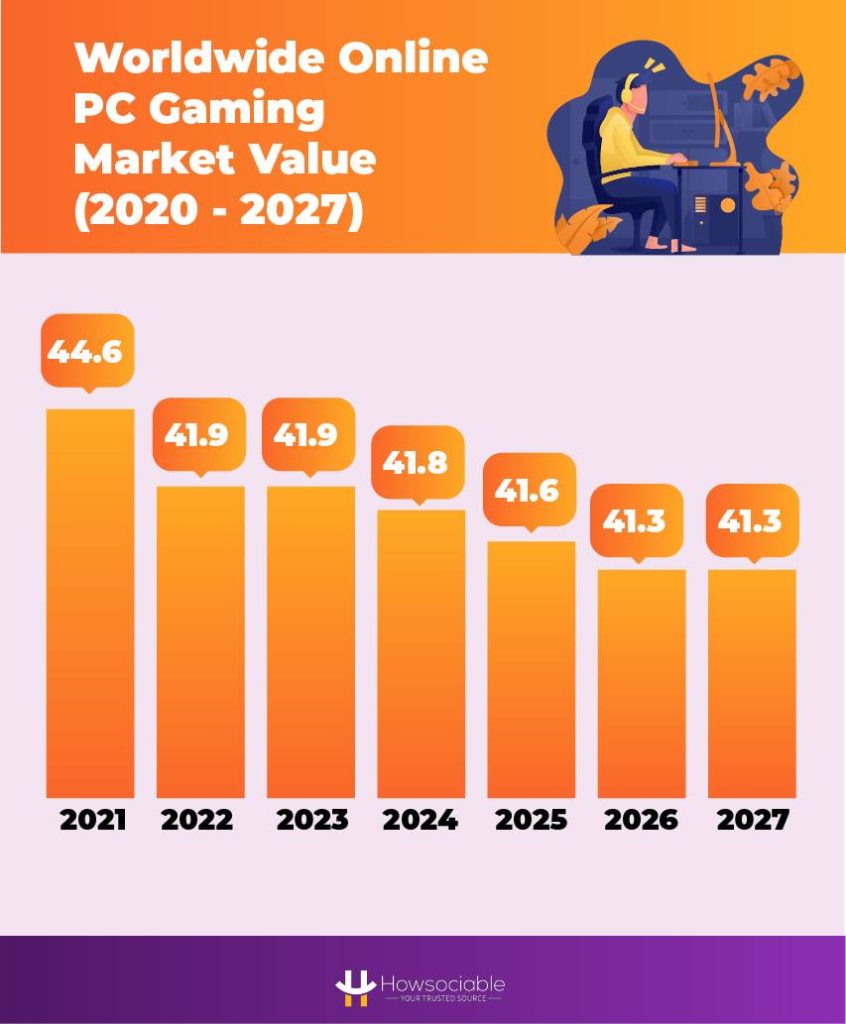
5. Understanding User Behavior: Mobile vs. Desktop
Examining the distribution of gaming revenue and user preferences sheds light on the ongoing competition between mobile and desktop platforms.
- Mobile gaming is projected to generate 71% of Google Play’s revenue by 2025, indicating its enduring significance despite a slight decrease from previous years (85% in 2019, 83% in 2020, and 80% in 2021). (Vpnalert)
Mobile vs. Desktop News Consumption
The way we consume news has witnessed a significant shift, driven by the ubiquity of mobile devices. Below are the statistics that reveal the disparities between mobile and desktop news consumption.
1. Mobile News Consumption Dominance
Mobile devices have revolutionized how people consume news, with an overwhelming majority of US adults relying on their smartphones to access news content.
- According to Gitnux, 90% of US adults access news through a mobile device.
2. Shift in News Consumption Habits
The advent of smartphones and mobile apps has significantly impacted the way people consume news, leading to a notable shift in their preferences and habits.
- A survey on news consumption revealed that between 2013 and 2022, the share of US consumers reading online news via a smartphone more than doubled, while consumption through computers or laptops decreased by about 30% (Statista).
News Consumption Evolution: Smartphone vs. Computer/Laptop
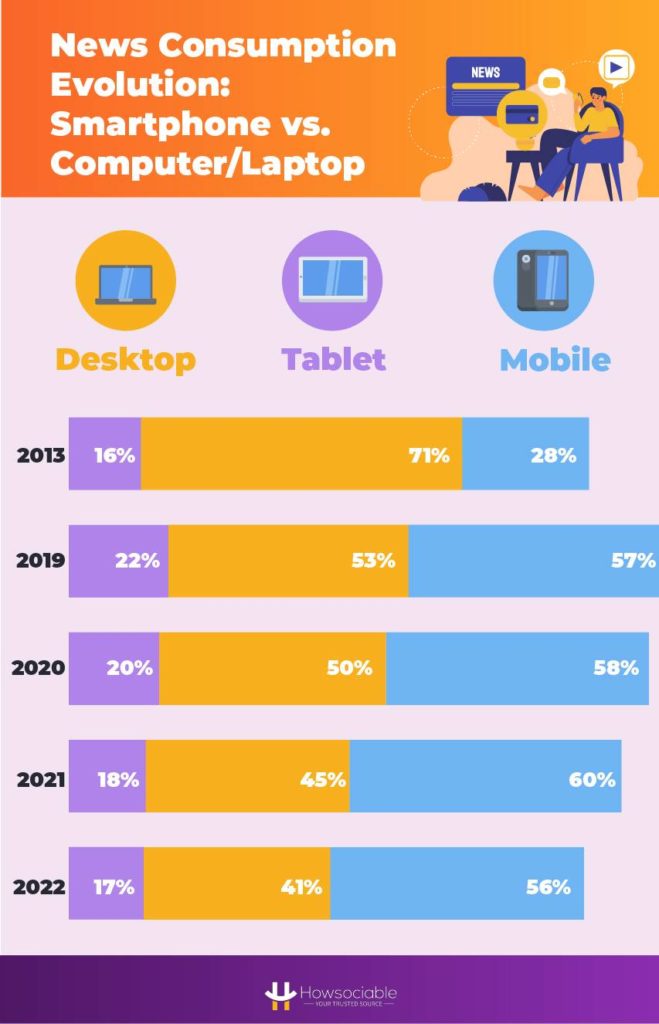
The infographic showcases the increasing prevalence of smartphones as the preferred device for accessing online news, highlighting a decline in computer or laptop usage.
3. Rise of Mobile News Consumption
With the growing popularity of smartphones and their integration into people’s daily lives, mobile devices are projected to play a significant role in media consumption, including news.
- By 2023, smartphones are expected to account for 35% of all media consumption, with a significant portion dedicated to news consumption (Curemedia).
Mobile vs. Desktop Travel and Booking Statistics
The travel and booking industry has experienced a significant transformation due to the widespread use of mobile and desktop devices. Here are the statistics that shed light on the disparities between mobile and desktop usage in travel and booking.
1. Abandonment Rates: Mobile vs. Desktop
When it comes to completing travel purchases, there is a notable difference in abandonment rates between mobile and desktop users.
- 85% of desktop users abandon their travel purchase, while the abandonment rate rises to 91% for those buying on a mobile device (SalesCycle).
2. Shift in Booking Platforms
The preference for booking platforms has witnessed a shift, indicating changing consumer behaviors.
- In 2022, 64% of online bookings are made on desktop, whereas 44% are made on a mobile device, showcasing a shift from the previous year (SalesCycle).
3. Mobile Research Dominance
Mobile devices play a crucial role in travel research, influencing travelers’ decision-making processes.
- 70% of all 148 million annual travelers conduct their research on a mobile device, indicating the dominance of mobile in the initial stages of travel planning (StratosJets).
- 83% of travelers use a mobile device for research before finalizing their travel plans, emphasizing the significance of mobile devices in the travel research phase (Think with Google).
4. Mobile Bookings on the Rise
The usage of mobile devices for travel bookings has been steadily increasing over the years.
- Mobile travel bookings accounted for 31% of bookings in 2019, rose to 37% in 2020, and further increased to 41% in 2021 (Salecycle).
- Between 2016 and 2021, the portion of online travel sales via mobile has consistently grown, reaching nearly 50% of all digital travel sales (dreambigtravelfar).
4. Conversion Rates: Mobile vs. Desktop
Conversion rates highlight the disparities between mobile and desktop bookings.
- The conversion rate for bookings made via mobile phones is 7%, whereas bookings made through desktop platforms have a conversion rate of 2.4%
Mobile vs. Desktop Streaming Statistics
The way we stream has also witnessed a remarkable transformation, with desktops losing their popularity in Asia as a preferred choice for streaming.
- In Asia, desktops now account for only 7% of viewing time, witnessing a drastic decline from 49% in 2021.
- Mobile devices have emerged as the dominant platform, representing 45% of streaming, followed closely by big screens, such as TVs, at 43% (Comparitech).
1. Mobile Dominance in Audio Streaming
When it comes to paid audio streaming services, mobile devices reign supreme among users.
- Approximately 80% of users prefer to listen to paid audio streaming services on their mobile devices, indicating the widespread adoption and convenience offered by mobile platforms. However, computers still play a significant role, contributing to 39% of usage (Cloudwards).
2. Differences in Viewing Duration
The duration of live streaming sessions varies across different devices, highlighting user preferences and habits.
- On average, viewers spend approximately 5 minutes watching live streams on mobile devices, 7.1 minutes on tablets, and significantly longer periods of 34.5 minutes on desktops (financesonline).
Conclusion
This article explored the comparison between mobile and desktop usage in various domains, including gaming, news consumption, banking and financial services, travel and booking, and streaming. The provided statistics highlighted the increasing prevalence of mobile devices as the preferred choice for accessing content and conducting activities.
Mobile devices have revolutionized how people engage with gaming, consume news, perform banking transactions, make travel bookings, and stream content. The data showed significant shifts in user behavior, with mobile devices gaining dominance in many areas previously dominated by desktops. These insights reflect the evolving technological landscape and the changing preferences of users in an increasingly mobile-centric world.

Comments